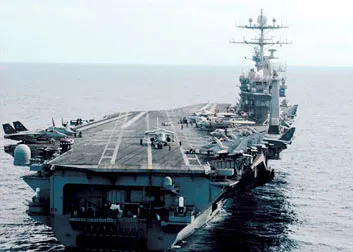The Meatball
Pilots who make it safely to the deck of an aircraft carrier have seen the light.
/https://tf-cmsv2-smithsonianmag-media.s3.amazonaws.com/filer/meatball-388-may05.jpg)
To imagine landing on an aircraft carrier, picture falling 70 stories toward the ocean each minute with nothing but a glorified traffic light to tell you if you’re on track to snag an arresting wire, or whether you’re about to crumple yourself against the carrier’s ramp.
Naval aviators know that traffic light as the Improved Fresnel Lens Optical Landing System. A pilot uses IFLOLS to discern his glide slope—the angle at which aircraft descend and land—by tracking the up-and-down motion of a “meatball,” a bright amber light. The more closely aligned the meatball is with a horizontal row of green “datum” lights, the closer an aircraft is to its prescribed glide slope. (Coming in at too shallow an angle risks clipping the deck’s edge. Landing too steeply busts landing gear.)
The IFLOLS unit generates its meatball through an optical trick: A stack of 12 light cells produces a single ball-shaped image.
Within each cell, a reflector focuses light through an interference filter that passes only a narrow band of wavelengths: amber in the top 10 cells, red in the bottom two. The filtered light enters a fiber optic converter, which makes it easier to focus, and exits as an intensely bright line, about 10 inches long and a fraction of an inch high. It then passes through a series of elements that act as precision magnifying lenses.
If you were to peer into one of the 12 IFLOLS lenses from a distance of 20 feet, the magnified line would look like a crisp bar of light about an inch high and as wide as the five-inch-diameter lens face. As you move farther away, the bar would grow vertically and its edges would begin to fuzz. Farther yet—at around 500 feet—the bar would grow so big it would fill the lens: This circle is what pilots recognize as the meatball. And because the light exiting an IFLOLS unit is nearly collimated (the light rays travel almost parallel to one another), the meatball a pilot sees from distances greater than a quarter-mile is about 7.5 inches in diameter.
George Bray is a naval engineer who helped design the IFLOLS optics in the late 1980s and 1990s. He explains that the 12 cells, stacked in a slight convex curve like a bowed pillar of flashlights, make a six-foot arc of what would be a 240-foot circle. The effect, he says, is to make pilots believe that when they look at the column of light cells (the lenses are separated by an inch), they are looking through a tall, slender window at a ball of light 240 feet beyond the row of green datum lights.
As pilots ascend and descend, different cells combine to form an image of the meatball. “For example, if you move up, you’re gonna see it through the upper part of the ‘window’ [light cells closer to the top of the column],” says Bray. “If you move down, you’re gonna start to see it moving through the lower part of the window.” As many as three light cells or as few as one can be involved in producing the meatball.
At three-quarters of a nautical mile—the point at which daytime fliers turn for final approach and enter the “groove,” the last 15 to 18 seconds of flight—the meatball can be seen over a swath of sky roughly 135 feet tall by 3,300 feet wide. At night, pilots have more time to make course corrections; aircraft approach the ship straight on from 10 miles out, and the meatball—which is about a quarter as bright as high-beam auto headlights—is easier to find against a dark background. “Depending on how good your eyes are, you can start to pick it up at a mile and a half,” says Lieutenant Commander Joseph Krasinski, an F/A-18 pilot and the officer in charge of the Navy’s Landing Signal Officer School at Naval Air Station Oceana in Virginia Beach.
If a pilot sees amber, he is seeing the meatball through the upper part of the IFLOLS window, and his wheels should hit the deck. But if the meatball turns pinkish or red—meaning he’s seeing one of the bottom two cells—the poop deck is just seconds away, so he should pull up and peel off for a second try.
Under normal circumstances—average wind and seas—the ideal glide slope is centered at 3.5 degrees above the deck, which equates to 14.1 feet of clearance between aircraft hooks and the aft edge of the deck. But according to F/A-18 pilot Matthew Pothier, a former LSO school officer in charge, stormy seas can call for adjustments: “If the aircraft carrier is [pitching up and down] plus or minus 10 feet…that clearance factor starts to get a lot lower than 14.1 feet, because the lens itself—the meatball—is stabilized not to the aircraft’s movement but to the horizon, basically. So we’ll go ahead and adjust that glide slope up to four degrees. That’s usually the maximum we’ll land at, and that’s going to give us more hook-to-ramp clearance, basically—a couple more feet.”
Conversely, if winds are high, the glide slope will actually be lowered.
And if the glide slope is flown perfectly—“What we always want guys doing is flying the ball all the way to touchdown,” says Krasinski—each aircraft’s hook should smack the deck in the middle of the landing area’s four arresting cables, between the 2- and 3-wires.
